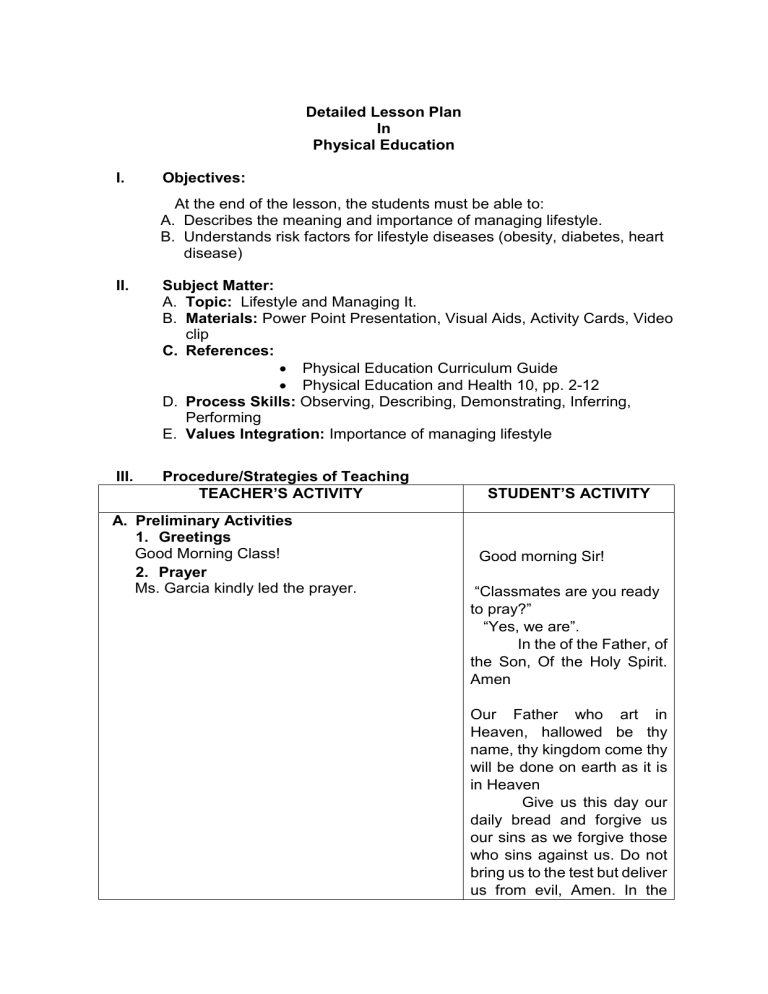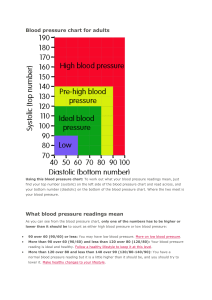LESSON PLAN 1
advertisement

Detailed Lesson Plan In Physical Education I. Objectives: At the end of the lesson, the students must be able to: A. Describes the meaning and importance of managing lifestyle. B. Understands risk factors for lifestyle diseases (obesity, diabetes, heart disease) II. Subject Matter: A. Topic: Lifestyle and Managing It. B. Materials: Power Point Presentation, Visual Aids, Activity Cards, Video clip C. References: Physical Education Curriculum Guide Physical Education and Health 10, pp. 2-12 D. Process Skills: Observing, Describing, Demonstrating, Inferring, Performing E. Values Integration: Importance of managing lifestyle III. Procedure/Strategies of Teaching TEACHER’S ACTIVITY A. Preliminary Activities 1. Greetings Good Morning Class! 2. Prayer Ms. Garcia kindly led the prayer. STUDENT’S ACTIVITY Good morning Sir! “Classmates are you ready to pray?” “Yes, we are”. In the of the Father, of the Son, Of the Holy Spirit. Amen Our Father who art in Heaven, hallowed be thy name, thy kingdom come thy will be done on earth as it is in Heaven Give us this day our daily bread and forgive us our sins as we forgive those who sins against us. Do not bring us to the test but deliver us from evil, Amen. In the name of the Father of the Son of the Holy Spirit, Amen. 3. Arranging of Chairs Everybody kindly arranges your chairs and sit properly. 4. Checking of Attendance May I know who are absent today? No one, Sir! Row 1 No one, Sir! Row 2 No one, Sir! Row 3 Very Good! It’s nice to hear that no one is absent. B. Recapitulation Yes, Sir. Mr. Troyo, can you give me some recap on what Last meeting, I learned that you have learned from our discussion last the different systems of our meeting? body are very important as a human being and we must take good care of it. C. Motivation Class, I have different pictures. (Post the pictures) What you observed on the pictures? What was it all about? Yes, that’s right! What do you understand about lifestyle? D. Presentation/Discussion LIFESTYLE AND MANAGING IT The way in which an individual lives is called lifestyle. This includes the typical patterns of an individual’s behavior like everyday routine at home, in school, or at work; eating, sleeping, and exercise habits, and many others. These patterns of behavior are related to elevated or reduced health risk. Teenagers like you may have practices or habits at home or in school that either elevate or reduce Sir, the pictures show different lifestyle of a person and how they manage it accordingly. Sir, lifestyle for us is the way an individual life. It includes the typical patterns of an individual’s behavior like everyday routine and all. health risks. Do you spend a lot of your time at home just sitting down and doing nothing? Do you move a lot by helping out at home, cleaning your house for example? Do you love eating fruits and vegetables? Or do you prefer junk food or fast food? Teenagers like you should be more aware on ow your nutritional practices can affect your health. Managing your lifestyle entails making modifications in your routine especially in those aspects that elevate health risks. Food choice, physical activity, and eating habits are some of the aspects of your lifestyle that can be modified to improve it. These modifications should be done gradually, like reducing the intake of fatty food, getting up to reach for something instead of asking someone to get it for you, or walking faster and more often. The idea is that for health risks to be reduced, changes in your lifestyle should be made. Risk factors are variables in your lifestyle that may lead to certain diseases. Many aspects of your lifestyle can be considered risk factors. Aside from genetics or heredity, age and physical make-up are some of the factors that cannot be changed; however, your lifestyle can go around these factors to gain more benefits. For instance, you cannot stop the aging process, but you can delay the signs of aging from showing by being more active and avoiding vices. The other variables in your lifestyle, however, can be modified to achieve a healthier life. Such variables include nutrition, body weight, physical activity, and healthy habits. What should be kept in mind is that these variables bring with them risk factors that are serious concerns. Some of the risk factors associated with lifestyle variables include hypertension/ high blood pressure, overweight and obesity, excess body fat, high levels of stress, lack of exercise and sedentary lifestyle, smoking, unhealthy dietary practices, and alcohol consumption. An unhealthy lifestyle brings with its certain diseases that can shorten your lifespan. These diseases, known as non-communicable diseases (NCDs), are not transmitted from person to person, yet kill more than 36 million people each year. Also called chronic diseases, they are of long duration, and are generally of slow progression. The four main types of NCDs are cardiovascular diseases (like enlargement of the heart and hypertension), cancer, chronic respiratory diseases (such as chronic obstructed pulmonary disease and asthma), and diabetes. All age groups are affected by NCDs, although they are often associated with older age groups. Evidence shows that more than nine million of the deaths attributed to NCDs occur before the age of 60. Children and adults are vulnerable to the risk factors that lead to non-communicable diseases, whether from unhealthy diet, physical inactivity, exposure to tobacco smoke, or the harmful effects of alcohol. It is important these factors are addressed even at your teenage years. You could start by being more active, adding physical activity sessions to your daily routine, or by being a healthy eater, opting for more nutritious food. Activity 1. Race to Connect Materials Manila paper Masking tape Chairs Words and pictures posted on chairs Procedures 1. Form a group with 5 to 8 members each. 2. Each group races to stand behind the chair with the word that they think significantly connects weight to lifestyle. Only one group can occupy a chair. Groups could switch places until the signal to stay is given. 3. Discuss your group’s choice of word or picture. Categorize your choice: Is it about nutrition/food, or physical activity/ exercise? Activity 2. What Is It for You? Materials Manila paper Masking tape Pen Activity notebook Procedures 1. Form groups of 5 to 8 members each. 2. Using a concepts map, writs words associated with “lifestyle’ inside the circles. You may add more if necessary. Do this in your activity notebook. 3. Focus on the following: Describe the words given. What were the words commonly given by the group? Why do you think these words were given? What words were mentioned only once? Are these words important? 4. Define “lifestyle” based on the words given by each member. 5. Chooses one representative to do the presentation for 3 minutes. LIFESTYLE Analysis Ms. Pardilla, what can you say about the activity that Sir!! The activity was so fun. you and your classmates have done today? Not only did we enjoyed it, we also learned so much from these. Very Good! Class, let us give an around of applause to Ms. Pardilla. Thank you, Ms. Pardilla you may take your seat. Abstraction Mr. Rojas can you please give a summary about our discussion today? Managing your lifestyle entails making modifications in your routine especially in those aspects that elevate health risks. An unhealthy lifestyle brings with its certain diseases that can Good Job! Class let us also give an around of shorten your lifespan. applause to Mr. Rojas. Thank you, Mr. Rojas. Generalization What is lifestyle? Yes, Ms. Marina? Lifestyle is how you live your Very Good! Let us give her an around of applause! life. What you eat and what you do most of the day. Thank you! Do you really understand the topic today? Is, there any questions regarding our topic for today? Application Ms. Demate, what are the things we should do on managing our lifestyle? Yes, Sir!!! None, Sir!!! Managing your lifestyle entails making modifications in your routine especially in those aspects that elevate health risks. The things we can do to manage our lifestyle properly is that choosing the right food, doing physical activity, and healthier eating habits can improve our lifestyle. These modifications should be done gradually, like reducing the intake of fatty food, getting up to reach for something instead of asking someone to get it for you, or walking faster and more often. The idea is that for health risks to be reduced, Class, I want to congratulate you all for a job well changes in your lifestyle done. To those who volunteered in answering should be made. questions, you will receive additional points, but for those who did not, still continue to strive and try harder next time. I just want you to learn more about this subject. God Bless Everyone! IV. Evaluation: Essay type 1.) What should be done to avoid chronic diseases? 2.) How can we manage our lifestyle properly? V. Assignment: Assignment no. 1 For your assignment cut out at least 5 pictures of chronic diseases and explain how you can prevent this from happening. Write it in short bond paper. Assignment no. 2 Product-oriented Performance Task Task: Create a scrapbook about different kinds of chronic diseases and use an indigenous material for it. The output will be graded based on the rubrics attached below. SCALE 4 HOLISTIC RUBRICS CRITERIA At least 4 accurate facts of information regarding on the picture in the scrapbook. Selection, combination of color, size, design and arrangement of the picture contribute exactly information and the overall is very creative and nice. 3 2 1 At least 3 accurate facts of information regarding on the picture in the scrapbook. Selection, combination of color, size, design and arrangement of the picture are eye catching and contribute exactly information. At least 2 accurate facts of information regarding on the picture in the scrapbook. Selection, combination of color, size, design and arrangement of the picture are present but do not contribute information regarding of the picture. At least 1 accurate facts of information regarding on the picture in the scrapbook. Selection, combination of color, size, design and arrangement on the picture are misleading.


